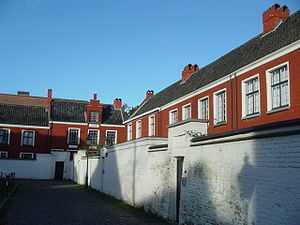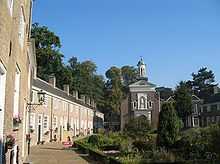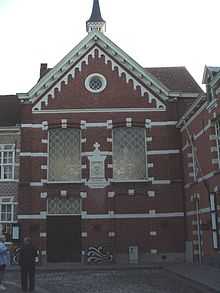Béguinage
| Flemish Béguinages | |
|---|---|
| Name as inscribed on the World Heritage List | |
 The Our Lady Ter Hoyen béguinage, one of the three béguinages in Ghent | |
| Type | Cultural |
| Criteria | ii, iii, iv |
| Reference | 855 |
| UNESCO region | Europe and North America |
| Inscription history | |
| Inscription | 1998 (22nd Session) |
The word béguinage is a French term that refers to a semi-monastic community of women called Beguines, religious women who sought to serve God without retiring from the world, as well as to the architectural complex that housed such a community. The word has been absorbed into English, where it is typically written without an accent. There are two types of beguinages: small, informal, and often poor communities that emerged across Europe from the twelfth century on, and the Court Beguinages (begijnhof (Dutch)), a much larger and more stable type of community that emerged only in the region of the Low Countries in the first decades of the thirteenth century.
Description
While a small beguinage usually constituted just one house where women lived together, a Low Countries Court Beguinage typically comprised one or more courtyards surrounded by houses, and also included a church, an infirmary complex, and a number of communal houses or 'convents'. From the twelfth century through the eighteenth, every city and large town in the Low Countries had at least one Court Beguinage (they shut down, one by one, in the nineteenth and twentieth centuries). They were encircled by walls and separated from the town proper by several gates which were closed at night. During the day the Beguines could come and go as they pleased. Beguines came from a wide range of social classes, though truly poor women were only admitted if they had a wealthy benefactor who pledged to provide for their needs.
Our understanding of women's motivations for joining the Beguinages has changed dramatically in recent decades. The development of these communities is clearly linked to a preponderance of women in urban centers in the Middle Ages, but while earlier scholars like the Belgian historian Henri Pirenne believed that this "surplus" of women was caused by men dying in war, that theory has been debunked. Since the groundbreaking work of John Hajnal, who demonstrated that, for much of Europe, marriage occurred later in life and at a lower frequency than had previously been believed, historians have established that single women moved to the newly developed cities because those cities offered them work opportunities. Walter Simons has shown how the smaller beguinages as well as the Court Beguinages answered those women's social and economic needs, in addition to offering them a religious life coupled with personal independence, which was a difficult thing to have for a woman.
Béguinages in Belgium


- Aarschot
- Antwerp
- Bruges: Ten Wijngaerde
- Dendermonde
- Diest
- Diksmuide
- Ghent: Old Saint-Elisabeth, New Saint-Elisabeth in Sint-Amandsberg and Our-Lady Ter Hooyen
- Hasselt
- Herentals
- Hoogstraten
- Lier
- Leuven: Grand Béguinage, Leuven and Small
- Mechelen: Large and Small
- Kortrijk
- Sint-Truiden
- Turnhout
- Tongeren
The Flemish Béguinages have been a UNESCO World Heritage Site since 1998[1]
Other Béguinages
- Begijnhof, Amsterdam, Netherlands
- Breda, Netherlands
- Béguinage de Saint Vaast, Cambrai, France
- Béguinage, Valenciennes
- Elm Hill Houses, Norwich, England
See also
Notes
- ↑ "Flemish Béguinages". List of World Heritage. Unesco.
References
| Wikimedia Commons has media related to Béguinage. |
- Tanya Stabler Miller, The Beguines of Medieval Paris: Gender, Patronage, and Spiritual Authority (2014)
- Walter Simons, Cities of Ladies: Beguine Communities in the Medieval Low Countries, 1200-1565 (2001)
External links
| |||||||||||||||||||||
